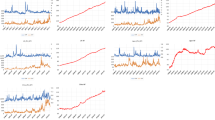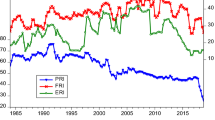Abstract
This paper analyzes the time-varying relationship between risk aversion and both conventional and unconventional monetary policy in an international context and at different frequencies using a wavelet coherency analysis. Our main results suggest the existence of a dynamic relationship between the two variables depending on timescales and on the periods. Thus, a short-run negative relationship leading from the risk aversion variable to the monetary policy measure is found for most of the period, suggesting that monetary policy reacts more aggressively in periods of high risk aversion. Furthermore, during the financial crisis, we find a long-run negative relationship leading from the monetary policy to the risk aversion index, suggesting that a lax monetary policy could lead to financial instability. US monetary policy has also significant effects on the risk aversion rates in the Euro Area, Japan and the UK.




Similar content being viewed by others
Notes
See Torrence and Compo (1998) for more details about cross-wavelet spectrum hypothesis and confidence levels.
The main principles underlying SSR estimates are: Yield curve data, i.e., market-quoted interest rates of different times to maturity, are influenced by the policy interest rate (PIR) and unconventional monetary policy (UMP) tools (when the latter are in use). The yield curve may be considered as two components: a shadow yield curve without a near-ZLB constraint that can therefore freely take on negative values; and a physical currency option effect that results in a near-ZLB constraint on interest rates. Applying a shadow or lower bound model to yield curve data allows the shadow yield curve and the option effect components to be separately estimated. The SSR is then the shortest-maturity interest rate on the shadow yield curve, just like the PIR is the shortest-maturity interest rate on the actual yield curve. Because the shadow or lower bound model is estimated from yield curve data across UMP and conventional monetary policy (CMP) periods, the resulting SSR series provides a consistent and comparable metric for the stance of monetary policy over both periods.
The data can be downloaded from the following link: https://www.rbnz.govt.nz/research-and-publications/research-programme/additional-research/measures-of-the-stance-of-united-states-monetary-policy/comparison-of-international-monetary-policy-measures.
As a preliminary analysis, we estimate a quantile-on-quantile regression as outlined in Sim and Zhou (2015), to understand the underlying relationship between the time-dependent phases of the two variables, i.e., the risk aversion and the interest rate. The results have been plotted in Figs. A2 and A3 in the online Appendix, and, in general, tend to suggest a theory-consistent negative relationship between the two variables across the various quantiles.
When the phase-difference is converted to an angle in the interval\(\left[ { - \pi ,\pi } \right]\), an absolute value less (larger) than $$\pi /2$$ indicates that the two series move in phase (anti-phase).
Given that the risk aversion data is available monthly as well over the period of 1986:06–2015:02, in Fig. A3 in the online Appendix, we analyzed the impact of an interest rate (i.e., the Shadow Short Rate) shock on risk aversion, and the feedback from risk aversion on to the interest rate in a vector autoregressive (VAR) model, with growth in industrial production and inflation as additional variables. The data on industrial production and consumer price index are derived from the FRED database of the Federal Reserve Bank of St. Louis. The variables in the VAR (12) are ordered as industrial production growth, inflation, interest rate and risk aversion. As can be seen, from the impulse responses, interest rate and risk aversion moves in opposite direction following a positive shock to either of these two variables. When a robustness test is conducted by replacing risk aversion with the variance risk premium (VRP), as developed by Zhou (2018) (with the data downloadable from: https://sites.google.com/site/haozhouspersonalhomepage/?authuser=1), in the VAR(12) estimated over 1990:01 to 2018:12, the earlier results continue to hold, as seen from Fig. A5 in the online Appendix.
In fact, preliminary evidence, based on the simultaneous test of causality-in-mean and causality-in-variance using a factor double autoregressive (FDAR) model, as developed by Guo et al. (2014), highlights that the null of simultaneous non-causality is strongly rejected in both directions for the US, Euro Area, Japan and the UK, as reported in Table A1 in the Online Appendix of the paper.
References
Adrian T, Shin HS (2009) Money, liquidity, and monetary policy. Am Econ Rev 99(2):600–605
Adrian T, Shin HS (2010) Financial intermediaries and monetary economics. In: Friedman BM, Woodford M (eds) Handbook of monetary economics. Elsevier, New York, pp 601–650
Aguiar-Conraria L, Azevedo N, Soares MJ (2008) Using wavelets to decompose the time–frequency effects of monetary policy. Phys A 387(12):2863–2878
Antonakakis N, Gabauer D, Gupta R, Plakandaras V (2018) Dynamic connectedness of uncertainty across developed economies: a time-varying approach. Econ Lett 166:63–75
Baruník J, Vácha L, Krištoufek L (2011) Comovement of Central European stock markets using wavelet coherence: evidence from high-frequency data. IES Working paper 22/2011, IESFSV. Charles University
Bekaert G, Hoerova M, Lo Duca M (2013) Risk, uncertainty and monetary policy. J Monet Econ 60:771–788
Bekaert G, Engstrom EC, Xu NR (2017) The time variation in risk appetite and uncertainty. Columbia Business School research paper no. 17-108
Bonfim D, Soares C (2018) The risk-taking channel of monetary policy: exploring all avenues. J Money Credit Bank 50:1507–1541
Borio C, Zhu H (2012) Capital regulation, risk-taking and monetary policy: a missing link in the transmission mechanism? J. Financ Stabil 8:236–251
Bruno V, Shin HS (2015) Capital flow and the risk-taking channel of monetary policy. J Monet Econ 71:119–132
Christou C, Naraidoo R, Gupta R (2020a) Conventional and unconventional monetary policy reaction to uncertainty in advanced economies: evidence from quantile regressions. Stud Nonlinear Dyn Econ 24(3):1–17
Christou C, Naraidoo R, Gupta R, Hassapis C (2020b) Monetary policy reaction to uncertainty in Japan: evidence from a quantile-on-quantile interest rate rule. Int J Finance Econ. https://doi.org/10.1002/ijfe.2258
Dajcman S (2016) The bank lending channel of monetary policy and its macroeconomic effects: evidence from a sample of selected Euro area countries. Eng Econ 27(2):124–133
Demirer R, Omay T, Yuksel A, Yuksel A (2018) Global risk aversion and emerging market return comovements. Econ Lett 173:118–121
Evans C, Fisher J, Gourio F, Krane S (2015) Risk management for monetary policy near the Zero Lower Bound. Brook Pap Econ Act Spring 2015:141–219
Gambacorta L (2009) Monetary policy and the risk-taking cannel. BIS Quarterly Review, Bank for International Settings
Gambacorta L, Marqués-Ibáñez D (2011) The bank lending cannel: lessons from the crisis. Econ Policy 26:135–182
Gnabo JY, Moccero DN (2015) The risk management approach to monetary policy, nonlinearity and aggressiveness: the case of the US Fed. European Central Bank WP 1792
Grinsted A, Moore JC, Jevrejeva S (2004) Application of the cross wavelet transform and wavelet coherence to geophysical time series. Nonlinear Process Geophys 11(5/6):561–566
Guiso L, Sapienza P, Zingales L (2018) Time varying risk aversion. J Financ Econ 128:403–421
Guo S, Ling S, Zhu K (2014) Factor double autoregressive models with application to simultaneous causality testing. J Stat Plan Infer 148:82–94
Hahn J, Jang WW, Kim S (2017) Risk aversion, uncertainty, and monetary policy in zero lower bound environments. Econ Lett 156(118):122
Ho SP, Pan C, Yeh C, Hsu Y (2010) Characteristics of and relations between housing cycles and economic fluctuations: a time-frequency analysis. In: Conference: 2nd ReCapNet conference, Mannheim, Germany. https://doi.org/10.13140/2.1.4478.544
Hudgins L, Friehe CA, Mayer ME (1993) Wavelet transforms and atmopsheric turbulence. Phys Rev Lett 71(20):3279
Inekwe NJ (2016) Financial uncertainty, risk aversion and monetary policy. Empir Econ 51:939–961
International Monetary Fund (2016) Monetary policy and central banking. https://www.imf.org/en/About/Factsheets/Sheets/2016/08/01/16/20/Monetary-Policy-and-Central-Banking
Jiménez G, Ongena S, Peydró JL, Saurina J (2014) Hazardous times for monetary policy: what do twenty-three million bank loans say about the effects of monetary policy on credit risk-taking? Econometrica 82:463–505
Krippner L (2013) A tractable framework for zero lower bound Gaussian term structure models. Discussion paper, Reserve Bank of New Zealand, 2013/02
Kurov A, Stan R (2018) Monetary policy uncertainty and the market reaction to macroeconomic news. J Bank Finance 86:127–142
Mishkin FS (2009) Is monetary policy effective during financial crises. Am Econ Rev 99:573–577
Mishkin FS (2011) Monetary policy strategy: lessons from the crisis. National Bureau of Economic Research, NBER 16755
Mumtaz H, Theodoridis K (2019) Dynamic effects of monetary policy shocks on macroeconomic volatility. J Monet Econ. https://doi.org/10.1016/j.jmoneco.2019.03.011
Nakamura E, Steinsson J (2018a) High frequency identification of monetary non-neutrality: the information effect. Q J Econ 133:1283–1330
Nakamura E, Steinsson J (2018b) Identification in macroeconomics. J Econ Perspect 32:59–86
Nave JM, Ruiz J (2015) Risk aversion and monetary policy in a global context. J Financ Stabil 20:14–35
Rajan R (2006) Has finance made the world riskier? Eur Financ Manag 12:499–533
Rua A, Nunes LC (2009) International comovement of stock market returns: a wavelet analysis. J Empir Finance 16(4):632–639
Sim N, Zhou A (2015) Oil prices, US stock return, and the dependence between their quantiles. J Bank Finance 55:1–8
Tiwari AK, Nasreen S, Shahbaz M, Hammoudeh S (2020) Time-frequency causality and connectedness between international prices of energy, food, industry, agriculture and metals. Energy Econ 85:104529
Torrence C, Compo GP (1998) A practical guide to wavelet analysis. Bull Am Meteor Soc 79(1):61–78
Torrence C, Webster PJ (1999) Interdecadal changes in the ENSO–monsoon system. J Clim 12(8):2679–2690
Zhou H (2018) Variance risk premia, asset predictability puzzles, and macroeconomic uncertainty. Ann Rev Financ Econ 10:481–497
Acknowledgements
We would like to thank two anonymous referee for many helpful comments. However, any remaining errors are solely ours.
Funding
Juncal Cuñado gratefully acknowledges financial support from the Ministerio de Economía y Competitividad (ECO2017-83183-R).
Author information
Authors and Affiliations
Corresponding author
Ethics declarations
Conflict of interest
The authors declare that they have no conflict of interest.
Ethical approval
This article does not contain any studies with human participants or animals performed by any of the authors.
Additional information
Publisher's Note
Springer Nature remains neutral with regard to jurisdictional claims in published maps and institutional affiliations.
Supplementary Information
Rights and permissions
About this article
Cite this article
Hkiri, B., Cunado, J., Balcilar, M. et al. Time-varying relationship between conventional and unconventional monetary policies and risk aversion: international evidence from time- and frequency-domains. Empir Econ 61, 2963–2983 (2021). https://doi.org/10.1007/s00181-020-02004-0
Received:
Accepted:
Published:
Issue Date:
DOI: https://doi.org/10.1007/s00181-020-02004-0




